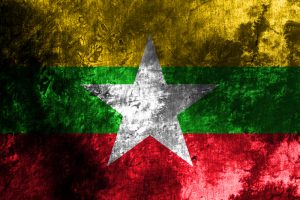Among the latest of many distressing videos to emerge from the killing fields of Myanmar was one of a young woman being decapitated, allegedly by army personnel who suspected her of being involved with a resistance group.
On July 1, the two-minute video went viral among some Myanmar communities that have taken refuge in neighboring countries after fleeing from brutal military raids.
A resident belonging to the Chin community in a border state of India’s northeastern region claimed that the woman was apprehended in Magwe Region after days of tracking by a combined squad of the military and loyalist militias known as Pyu Saw Htwe.
“What we have heard so far is that the woman was on the hit list of the army and its band of loyalists. She had been putting in efforts to convince a section of police personnel to join the People’s Defence Force (PDF). Apparently, one among them in the region had joined the PDF,” the resident said on condition of anonymity. “The information about the woman’s role seemed to have been leaked by some police personnel loyal to the regime.”
The chilling two-minute video shows the woman with tied hands kneeling at the porch of a wooden house with a man wielding a sword and standing by her side. The sword then descends on her neck and what followed thereafter bore a horrific similarity to some of the beheading videos released by the Islamic State not long ago.
The neck was not severed completely when the executioner seemed to have been instructed by his companion to complete the job. After it was finally separated with a few more blows, the sword was thrust three times into the stomach of the woman’s headless corpse.
Another member of the Indian refugee community was of the opinion that the video was deliberately filmed and leaked as a deterrent against similar efforts by the PDFs in the future.
Magwe, which lies in central Myanmar, is the second largest of the seven Bamar majority regions in the disturbed country. The resistance movement against the military regime has also been among the most potent in this zone, where conflict has historically been rare, compelling the military to adopt ruthless tactics to put an end to the rebellion that seems to have garnered wide support among the populace.
The latest ambush took place on June 9, when as many as 20 regime troops were reportedly killed following an ambush by the Yaw People’s Defense Force in Magwe’s Gangaw township.
Videos and photographs of unbelievable atrocities committed by the military against the civilian populace have also emerged intermittently from Sagaing Region and Chin State since last year, when the PDFs were formed in order to resist the military regime that seized power in February 2021. Along with Magwe, these two regions, which border India, are among the greatest hotspots of resistance in the country.
One video which was circulated among a section of the refugee community in India showed a male teenager being left to die by the military after being burned alive. He was reportedly a member of the Kalay PDF, which has been among the most active resistance squads in the country. Videos of settlements being raided and bombed were more common from Mindat township and the adjoining areas in southern Chin State, where a movement against the regime has become unflagging and widespread.
The military regime’s atrocities are reflective of its increasing desperation to retain power by any means necessary, in the face of a swelling resistance in a large part of the country. According to most estimates, its effective fighting strength is no more than 100,000-120,000 troops, who are currently battling a large number of PDFs, ethnic armed organizations, and other unidentified resistance groups.
While many PDFs are in alliance with the EAOs and owe their allegiance to the National Unity Government that has been set up to coordinate the resistance against the junta, some have been carrying out attacks independently, making the regime’s task of defeating them extremely difficult.

































